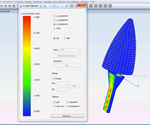Altair releases major software update to expand user solutions
The update enables accelerated innovation and targets design simulation and data analytics.

Source | Altair
Altair Engineering (Troy, Mich., U.S.), a global technology company providing solutions in product development, high-performance computing (HPC) and data analytics, announced on June 3 its complete company software products update, which is the largest collection of its applications for design, simulation and data analytics. In addition to expanding the number of solutions available for designers, engineers, data analysts, IT and HPC professionals and facility managers to drive better decisions and accelerate the innovation pace, the update release broadens the scope of the new user experience, enables access to more physics, data analytics and machine learning, and makes the Altair software delivery method more flexible and accessible. Other features like intuitive workflows have also improved, enabling users to streamline product development and allow customers to get to market faster. Altair says the most notable software update capabilities can be found in its applications, including industrial design and structures, manufacturing, electromagnetics and multiphysics, data analytics and more. All products are available through the Altair licensing model.
Related Content
-
The basics of composite drawing interpretation
Knowing the fundamentals for reading drawings — including master ply tables, ply definition diagrams and more — lays a foundation for proper composite design evaluation.
-
ATLAM combines composite tape laying, large-scale thermoplastic 3D printing in one printhead
CEAD, GKN Aerospace Deutschland and TU Munich enable additive manufacturing of large composite tools and parts with low CTE and high mechanical properties.
-
Jeep all-composite roof receivers achieve steel performance at low mass
Ultrashort carbon fiber/PPA replaces steel on rooftop brackets to hold Jeep soft tops, hardtops.












